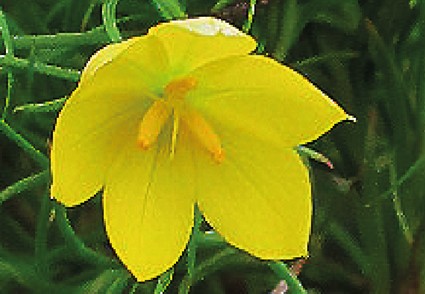Abstract
The Southern and Southeastern regions of Brazil present the highest species richness of Sisyrinchium, and the taxa are mainly distributed in the Atlantic Forest Biome. Here, three new species belonging to Sisyrinchium sect. Viperella from this biome are described: S. caratuvense is endemic to the high altitude grasslands of eastern Paraná, S. usneoides is endemic to the campo rupestre phytophysiognomy in southern Minas Gerais, and S. iguazuanum has a wider distribution, occurring in the grasslands of western Santa Catarina and Paraná (Brazil), and eastern Misiones (Argentina). Descriptions, illustrations, comparisons to related taxa and conservation status are provided.
References
Carvalho, C.I. (Coord.) (2019) Plano de Manejo da Área de Proteção Ambiental Boqueirão da Mira. Santa Rita de Jacutinga, Minas Gerais. 720 pp. Available from: http://www.srjacutinga.mg.gov.br/documentos/PLANO_APA_BM_FINAL_II.pdf (accessed 15 June 2021)
Chauveau, O., Eggers, L., Raquin, C., Silvério, A., Brown, S., Couloux, A., Cruaud, C., Kaltchuk-Santos, E., Yockteng, R., Souza-Chies, T.T. & Nadot, S. (2011) Evolution of oil producing trichomes in Sisyrinchium (Iridaceae): insights from the first comprehensive phylogenetic analysis of the genus. Annals of Botany (Oxford) 107: 1287–1312. https://doi.org/10.1093/aob/mcr080
Chukr, N.S. & Capellari Jr., L. (2003) Iridaceae. In: Wanderley, M.G.L., Sheperd, G.J., Melhem, T.S., Giulietti, A.M. & Kirizawa, M. (Eds.) Flora Fanerogâmica do Estado de São Paulo, vol. 3. FAPESP/RiMa, São Paulo, pp. 127–147.
Dauby, G., Stévart, T., Droissart, V., Cosiaux, A., Deblauwe, V., Simo-Droissart, M., Sosef, M.S.M., Lowry II, P.P., Schatz, G.E., Gereau, R.E. & Couvreur, T.L.P. (2017) ConR: An R package to assist large-scale multispecies preliminary conservation assessments using distribution data. Ecology and Evolution 7 (24): 11292–11303. https://doi.org/10.1002/ece3.3704
Eggers, L. & Inácio, C.D. (2020) Sisyrinchium. In: Flora do Brasil 2020. Jardim Botânico do Rio de Janeiro. Available from: http://floradobrasil.jbrj.gov.br/reflora/floradobrasil/FB8066 (accessed 28 June 2021).
Goldblatt, P., Rudall, P. & Henrich, J.E. (1990) The genera of the Sisyrinchium alliance (Iridaceae: Iridoideae): Phylogeny and relationships. Systematic Botany 15: 497–510. https://doi.org/10.2307/2419365
Goldblatt, P. & Manning, J.C. (2008) The Iris Family: natural history and classification. Timber Press, Portland, 290 pp.
Heiden, G. & Ribas, O.S. (2012) Baccharis umbellata (Asteraceae, Astereae): a new species endemic to the highest summits of Paraná, Southern Brazil. Phytotaxa 49: 23–28. https://doi.org/10.11646/phytotaxa.49.1.3
IBGE (2019) Biomas e Sistema Costeiro-Marinho do Brasil. Available from: https://www.ibge.gov.br/geociencias/cartas-e-mapas/informacoes-ambientais/15842-biomas.html?=&t=downloads (accessed 8 June 2021)
Inácio, C.D., Chauveau, O., Souza-Chies, T.T., Sauquet, H. & Eggers, L. (2017) An updated phylogeny and infrageneric classification of the genus Sisyrinchium (Iridaceae): challenges of molecular and morphological evidence. Taxon 66 (6): 1317–1348. https://doi.org/10.12705/666.4
IUCN Standards and Petitions Subcommittee (2019) Guidelines for Using the IUCN Red List Categories and Criteria. Version 14. Available from: http://www.iucnredlist.org/documents/RedListGuidelines.pdf (accessed 9 June 2021)
Karst, L. & Wilson, C.A. (2012) Phylogeny of the New World genus Sisyrinchium (Iridaceae) based on analyses of plastid and nuclear DNA sequence data. Systematic Botany 37: 87–95. https://doi.org/10.1600/036364412X616666
Linnaeus, C. (1753) Species plantarum, vol. 2. Impensis Laurentii Salvii, Holmiae [Stockholm]. https://doi.org/10.5962/bhl.title.669
Morales, M., Ribas, O.S. & Santos-Silva, J. (2012) A new polyploid species of Mimosa (Leguminosae, Mimosoideae) from the Highlands of Southern Brazil. Systematic Botany 37 (2): 399–403. https://doi.org/10.1600/036364412X635458
Myers, N., Mittermeier, R., Mittermeier, C., Fonseca, G.A.B & Kent, J. (2000) Biodiversity hotspots for conservation priorities. Nature 403: 853–858. https://doi.org/10.1038/35002501
Ravenna, P. (1981) Revisional studies in the genus Sisyrinchium – I. Wrightia 7 (1): 4.
Ravenna, P. (2000) Revisional studies in the genus Sisyrinchium (Iridaceae) VI. Onira 5 (4): 13–19.
Ravenna, P. (2002) Revisional studies in the genus Sisyrinchium (Iridaceae) IX. Onira 7 (6): 20–41.
Salisbury, R.A. (1812) On the cultivation of rare plants, especially such as have been introduced since the death of Mr. Philip Miller. Transactions of the Horticultural Society of London 1: 261–366.
Sprengel, C. (1824) Linnaeus Systema Vegetabilium. 16 ed. Dietrich, Gottingen, 992 pp.
Steudel, E.G. von (1841) Nomenclator Botanicus, 2 ed. Pars 2. Typus et Sumptibus J.G. Cottae, Stutgartiae et Tubingae, pp. 596.
Vellozo, J.M.C. (1829 “1825”) Florae fluminensis, seu, Descriptionum plantarum praefectura fluminensi sponte nascentium. Vol. 7. Rio de Janeiro: Typographia Nationali, pp. 273.


